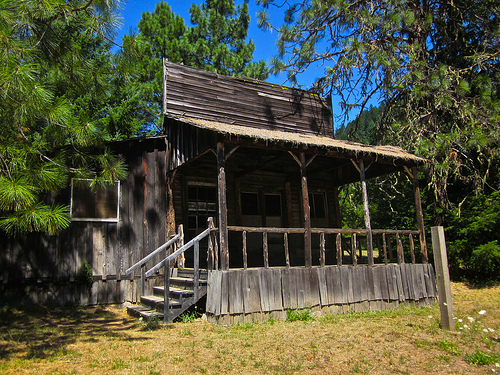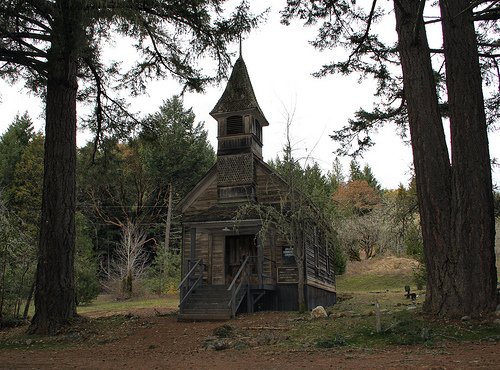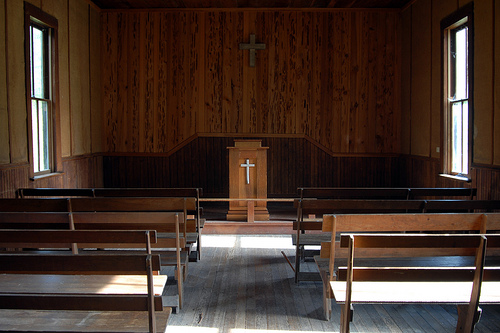

Location: Josephine County, OR Map
Found: 1840s
Golden, Oregon, is a well-preserved ghost town and historic mining site in Josephine County, located along Coyote Creek, approximately 10 miles northeast of Wolf Creek and 30 miles north of Grants Pass in Southern Oregon. Once a bustling 19th-century gold-mining camp that transitioned into a small town by the 1890s, Golden is now part of the Golden State Heritage Site, managed by Oregon State Parks and listed on the National Register of Historic Places in 2002. Distinguished as the “Driest Ghost Town in the West” due to its lack of saloons and emphasis on religious life, Golden’s four remaining structures—a church, a residence, a shed, and a combined post office and store—stand as testaments to its unique history. Situated in the scenic Illinois Valley, Golden attracts visitors, history enthusiasts, and ghost hunters for its intact buildings, mining relics, and serene setting, offering a glimpse into Oregon’s gold rush era and its cultural complexities.
Pre-European Context and Native Presence
Before European
settlement, the area around Golden was home to the Takelma,
Shasta, and other Indigenous peoples of the Rogue and Illinois
Valleys. These groups lived off the land, fishing salmon in the
Rogue River, hunting deer, and gathering acorns and berries.
Their presence is evident in archaeological sites, though mining
later disrupted many cultural landscapes. The 1848 California
Gold Rush, followed by discoveries in Southern Oregon, brought
drastic changes, displacing Native communities through violence,
disease, and land seizures during the Rogue River Wars
(1851–1856).
Gold Discovery and Early Mining
(1840s–1870s)
Golden’s history begins with the discovery of
gold in the late 1840s along Coyote Creek, a tributary of the
Illinois River, during the broader Southern Oregon gold rush
sparked by finds in Josephine Creek in 1851. European
prospectors, primarily from the United States and California,
settled the Wolf Creek area, establishing rudimentary mining
camps. By 1850, richer strikes in the Salmon River drew most
settlers away, leaving the area nearly deserted.
During
this lull, Chinese miners, many fleeing discriminatory laws in
California, moved into the abandoned claims. Facing Oregon’s
exclusionary policies, including a “whites only” clause in the
1859 state constitution, they worked marginal claims
efficiently, often purchasing “played-out” sites from white
miners. By the mid-1850s, returning European settlers drove out
the Chinese through intimidation and violence, reclaiming the
mines. This pattern of ethnic conflict, common in Oregon’s
mining regions, reflected the era’s racial tensions, with
Chinese miners facing exclusionary laws like the 1882 Chinese
Exclusion Act.
Mining resumed with placer techniques,
using sluice boxes to extract gold from creek beds. In the late
1870s, hydraulic mining, which used high-pressure water jets to
wash away hillsides, transformed the area. A 2.5-mile pipeline
fed “giant” nozzles, recovering $1.5 million in gold over
several years. The environmental toll was significant, with
stripped hillsides and diverted streams altering the landscape
permanently.
Establishment of Golden (1880s–1890s)
By
the mid-1880s, the Ruble family—William Ruble and his sons,
Schuyler and William Jr.—consolidated mining claims along Coyote
Creek, purchasing nearly all land east and west of Golden. Their
innovation, the Ruble Elevator, a hydraulic mining device that
separated gold from debris more efficiently, boosted production
and wealth. In 1890, the Rubles formally established Golden,
transforming the mining camp into a structured town.
Golden stood out for its moral character. Founded by religious
families, likely influenced by the Campbellite movement
(Disciples of Christ), the town prohibited saloons in its
center, earning its “Driest Ghost Town” moniker. Miners seeking
liquor traveled to the Wolf Creek Inn, 10 miles away. The town
featured two active churches, including a Campbellite church
built in the 1890s, and a large orchard, reflecting agricultural
efforts alongside mining.
By 1892, over 150 people lived
along Coyote Creek, with a peak population of about 100 in
Golden itself. Key developments included:
1885: A
schoolhouse, serving 36 children as late as 1906, was built 0.5
miles downstream, with teachers like Wilma Gilkey and Edith
Allen. Superintendent Lincoln Savage visited via train, bicycle,
and tramway from Grants Pass.
1892: A general store and
Campbellite church were constructed, serving as community hubs.
1896: The Golden post office opened, formalizing the town’s
status.
1915: A stamp mill, used to crush gold-bearing ore,
was built, indicating continued mining.
The Oregon-California
Stage Company detoured to Golden in the late 1870s to deliver
mail, passengers, and goods, underscoring its regional
importance.
Decline and Abandonment (1900–1950)
Gold
production slowed in the early 20th century as accessible
deposits dwindled. The post office closed in 1920, signaling
decline. By the mid-20th century, mining had largely ceased, and
residents left for urban centers like Grants Pass or Medford.
The Great Depression and World War II’s 1942 ban on
non-essential mining (War Production Board Order L-208) further
emptied Golden.
In 1950, the Campbellite church was
rebuilt, reflecting lingering community ties, but the town was
effectively abandoned. The Ruble family’s mining claims
remained, with some activity into the 1950s, but Golden’s heyday
had passed.
Preservation and Modern Era (1950–Present)
In 1968, Josephine County acquired the Ruble mining claims, and
in 2002, Oregon Parks and Recreation Department (OPRD) purchased
the site, establishing the Golden State Heritage Site. Listed on
the National Register of Historic Places in 2002, the site
preserves four buildings: a church, a residence, a shed, and the
post office/store. The Golden Historic District, encompassing
these structures, is maintained as a public park, with
interpretive signs detailing its history.
Golden’s
preservation highlights its unique character. Unlike rowdy
mining towns like Jacksonville, its religious foundation and
lack of saloons made it a family-oriented community. The site
has drawn media attention, appearing on the Travel Channel’s
Ghost Adventures for reported paranormal activity, boosting its
appeal to ghost hunters. The Josephine County Historical
Society’s marker at Golden provides a brief history, and local
historians like Kerby Jackson have documented its story.


Golden lies in the Illinois Valley, a scenic region of rolling hills
and coniferous forests at about 1,300 feet elevation. Coyote Creek, a
clear stream, runs through the site, flanked by pine, oak, and madrone
trees. The surrounding landscape bears scars of hydraulic mining, with
eroded hillsides and tailing piles, though wildflowers like lupine and
Indian paintbrush bloom in spring. Wildlife includes deer, foxes, and
birds like ospreys and kingfishers.
Access is straightforward but
requires planning:
By Car: From Grants Pass, take U.S. Route 199
south to Wolf Creek (20 miles), then follow Coyote Creek Road east for
10 miles. The road is paved but narrow; allow 45 minutes. From I-5, exit
at Wolf Creek and follow signs to Golden.
Conditions: The site is
open year-round, sunrise to sunset, but spring (April–June) offers the
best weather and wildflowers. Winter may bring mud or light snow.
Facilities: No restrooms, water, or visitor center are available. The
nearest amenities are in Wolf Creek (gas, food) or Grants Pass. Bring
water, snacks, and sturdy shoes for uneven terrain.
The site is
free to visit, with parking for a few vehicles. Visitors should stay on
paths to avoid fragile structures and respect the no-smoking rule due to
fire risks.
The Golden State Heritage Site preserves four wooden buildings,
stabilized but unrestored to maintain their historical authenticity:
Church: The rebuilt 1950 Campbellite church, with simple clapboard
siding, reflects the town’s religious core. Its interior, with pews and
a pulpit, is occasionally open for tours.
Residence: A small home,
likely from the 1890s, with weathered siding and a porch, hints at
family life.
Post Office/Store: A combined structure, with shelves
and a counter, served as Golden’s commercial hub. Its exterior is iconic
for photographers.
Shed: A modest outbuilding, possibly for storage
or mining tools, completes the ensemble.
The buildings, perched above
Coyote Creek, are surrounded by mining relics like rusted equipment and
ditches. The site’s listing on the National Register ensures protection,
with OPRD maintaining the structures against weather and vandalism. The
absence of modern development enhances Golden’s ghost-town ambiance,
though its proximity to Wolf Creek makes it accessible.
Visiting Golden is a quiet, reflective experience, ideal for history
buffs and photographers. The 0.5-acre site takes 30–60 minutes to
explore, with signs explaining the buildings and mining history. The
church’s interior, when open, evokes the town’s spiritual life, while
the store’s faded shelves recall daily commerce. The surrounding valley,
with its creek and forested hills, invites short hikes, though no formal
trails exist. Visitors may spot mining ditches or tailing piles,
remnants of the hydraulic era.
Golden’s paranormal reputation,
fueled by Ghost Adventures, draws some, with reports of cold spots or
footsteps in the church. The site’s isolation—far from urban
noise—enhances its eerie charm, especially at dusk. Nearby, the Wolf
Creek Inn (1873), a historic stagecoach stop, offers dining and lodging,
complementing a visit.
Golden’s history encapsulates Southern Oregon’s gold rush dynamics:
Mining Innovation: The Ruble Elevator and hydraulic mining reflect
technological advances, though at environmental cost.
Ethnic
Tensions: The displacement of Chinese miners highlights Oregon’s racial
exclusion policies, with lasting impacts noted in a 1994 Oregon Supreme
Court report on institutional racism.
Religious Identity: Golden’s
sober, family-oriented character contrasts with saloon-heavy boomtowns,
offering a rare glimpse into moralistic mining communities.
Preservation: As one of Oregon’s few intact ghost towns, Golden
complements sites like Buncom and Sumpter, preserving the region’s
mining heritage.
The town’s story also reflects broader Oregon
themes: Native displacement, environmental transformation, and the
boom-and-bust cycle of resource extraction. Its inclusion in the
National Register and media features underscore its value as a
historical artifact.
Timing: Visit in spring for wildflowers or fall for cooler weather.
Summer is hot (90°F); winter may be muddy. Allow 1–2 hours, including
travel from Wolf Creek.
Preparation: Bring water, sunscreen, and
sturdy shoes. Cell service is spotty; download maps offline. A camera is
a must for the photogenic buildings.
Safety: Stay on paths to avoid
unstable ground or mining debris. Watch for poison oak and rattlesnakes
in summer. The site is safe but remote; inform someone of your plans.
Respect: Do not enter closed buildings or remove artifacts. Follow
“leave no trace” principles to protect the site.
Nearby: The Wolf
Creek Inn (10 miles) offers meals and history. Grants Pass (30 miles)
has the Oregon Caverns and Rogue River rafting. Buncom ghost town (50
miles) is another mining relic.
Events: Check oregonstateparks.org
for occasional guided tours or Josephine County Historical Society
events, like history walks.